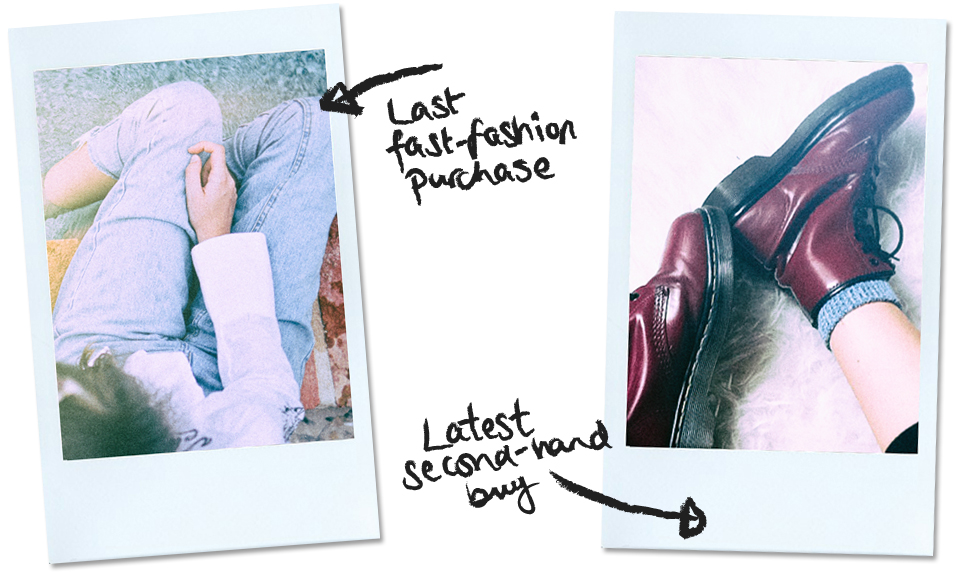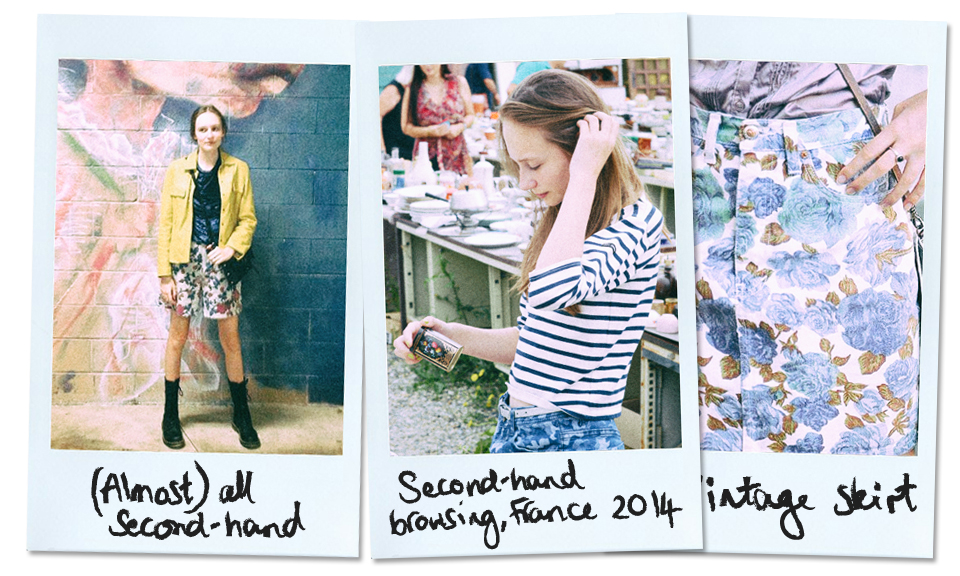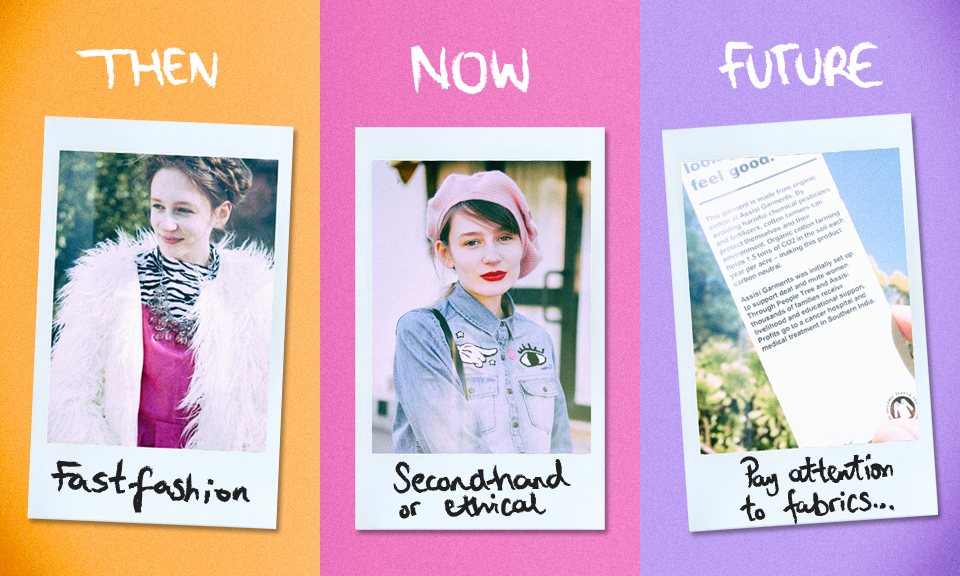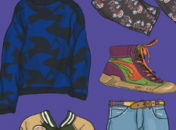In early 2016, I was still buying fast-fashion, even knowing that my purchase wouldn’t benefit anything other than my itch for wanting something new…
 Circa April 2013, I was sat in my living room, rocking back and forth in my chair as I read the news of the Rana Plaza disaster. This was the very first time I considered that the industry I loved might have scary and dangerous consequences. I was thirteen but go ahead and call me uneducated or close-minded if you so wish.
Circa April 2013, I was sat in my living room, rocking back and forth in my chair as I read the news of the Rana Plaza disaster. This was the very first time I considered that the industry I loved might have scary and dangerous consequences. I was thirteen but go ahead and call me uneducated or close-minded if you so wish.
The little I did know was extremely simple (and rather inaccurate) and barely scratched the surface on the real issues at hand – the clothes I bought were inexpensive because they were made cheaply and the more expensive they were, the higher quality they would be.
What literal schooling and the school-of-life hadn’t taught me was that cheaply really meant, unfairly. There’s always a reason why products are priced lowly or highly, after all. But for child and pre-teen me, it was exciting to shop, no matter how things were made.
![]()
It was an experience, one which I mostly shared with my mum and my sister. We’d go out on the weekends and we’d browse the latest offerings, piling up clothes to take to the changing rooms where we’d laugh and giggle when things didn’t fit right and joyously celebrate when a dress was ‘perfect’ and ‘so you’ (and also didn’t break the bank).
My sister moved out before I ever reached my tenth birthday so those shopping trips lessened. However, they only became more cherished when she’d come back to see me and we’d do what we hadn’t been able to do for however long it had been.
I’d go on days out with my mum too because that was what we did to treat ourselves, with Southampton’s West Quay being the destination of our choice.
To avoid being stereotypical and saying that only the women in my life were shopping-til-they-dropped, I also used to plan days out with my dad where we’d spend one-on-one time dressing each other up and treating ourselves to a KFC afterwards (it was a treat, thank you very much; their baked beans are second-to-none.)

This was all ordinary behaviour and to this day in western culture, still is. We go into town with our friends and we make a full day of it. You can make memories in high-street changing rooms.
Thankfully for me, I was never brought up to avoid charity shops or vintage stores despite the stigma that surrounds them, so, without even knowing it I often balanced out my new purchases with more sustainable ones.
I’d say the closest I got to a proper formal education on the negative aspect to our clothes and the fashion industry, would have been a school trip to a local landfill where we saw the piles of rubbish which included perfectly usable textiles.
Other than that, it took the collapse of a garment factory home to the products of Primark, for me to finally embark upon my ethical fashion journey.
![]()
It took me until summer 2016 to properly bid farewell to those sorts of purchases (excluding underwear – you can read why that is here), even though I was well aware that there were better alternatives and reasons to consume more consciously.
A lot of it had to do with my shopping habits rather than the actual clothes I was buying, though. It’s almost as if you experience withdrawal symptoms and every now and then you have to fall back into fast-fashions grasp and use the good ol’ excuse of ‘treating yourself’ but since when did treating yourself mean buying something which was made without people and the planet in mind?
Technically, your dopamine levels are the only part of the equation that is being treated, or, maybe the water used to make the fabric of your new dress, just with toxic chemicals, dyes and plastic micro-fibres.

I am by no means perfect, currently. For instance, I shop second-hand but I pay no attention to the fabrics I’m buying and now that I’m more educated, I know more about the impacts of other aspects of my life, yet I haven’t made many changes in those other problem areas.
It takes time to become more conscious individually and the rest of the industry following will also take time. It’s one of the reasons we need to shout about it loudly and proudly because the quicker it happens, the better!
The more you educate yourself and allow yourself to question what you’re used to, the easier it will become to make the right choices for you. It will also make it a lot easier for other people who haven’t even considered other ways of shopping and experiencing fashion, to educate themselves too.
![]()
My consumption habits and patterns in 2016 were tremendously better than those I had in 2013 and the ones I have now make me feel content and comfortable, however, there will always be room for improvement. If you feel hopeless or perhaps even a little guilty, take a breather and put things into perspective.
Take a trip down memory lane and take a look at the changes you’ve made so far. Is there anything more you can be doing now?
Do you have any ethical goals you’d like to achieve? Is there anything you want to learn more about? If my thirteen-year-old self had asked herself those questions, I’m sure I would have reached the stage I’m at now, far sooner.

Here are some Q&As to break-down my ethical journey…
When did I first become aware of the issues of fast-fashion?
Around 2013 – early 2014. The main chunk of my education came from the documentary, The True Cost, which was released around the same time. You can watch it on Netflix.
What was my first ethical purchase?
Other than the dozens and dozens of second-hand items I’ve consumed in my life, I believe it was an ASOS Africa blouse. Although ASOS may not be the most ethical or sustainable brand and I don’t know too much about how it was manufactured, I think it was a good starting place and allowed me to slowly transition from shopping there frequently to making more considered choices.
When was my last fast-fashion purchase?
I can’t remember the exact time or date or which purchase was officially the last but the four items I do remember buying last year (in the early months and possibly towards the end of 2015) were a pair of Motivi floral trousers, a Pull & Bear jumper and a pair of jeans, and an embroidered white shirt from Stradivarius (the latter two brands of which are owned by Inditex).
Although these purchases weren’t ethical, they are all still in my wardrobe. I’ve worn the floral trousers so much that the zip is now broken (and will soon be fixed, I promise!) and I probably won’t be buying any other jeans for a fair few years.
I don’t condone boycotting on a mass scale but if you can shop with alternative brands – which I believe most of you reading this will be able to do, even if it means not shopping at all for a while -, then avoiding fast-fashion is what I highly advise.
![]()
What has been one of the biggest struggles so far?
Not being able to buy anything overly elaborate or ‘out there’. By that I mean, not browsing through ASOS’s new-in and buying a ruffled midi-dress which is half-floral and half-sequin (that’s the first item that caught my eye on a very brief look at their latest offerings).
I’ve perfectly adapted to this change and I believe it’s made me make much more versatile style choices meaning my wardrobe is far more wearable than it ever was before, but I can understand why it’s easy to succumb to pieces that are totally out there and not easily accessible elsewhere (unless you’re making it yourself).
What is my next goal as a conscious consumer?
In terms of fashion purchases, I want to consider the fabrics I’m buying, whether that’s new or second-hand. I want to avoid bringing more polyester and man-made materials into my life to avoid the unwanted breakdown of fibres when washing, as well as wanting to consider the affects fabrics have on my body – who knows what chemicals are in what we wear?
Are you a conscious consumer? How far along are you on your ethical journey? What are your ethical goals? Share them in the comments!








14 Comments
In the last year or so I have been shopping only at charity shops. I find the quality is far superior to fast fashion items at a fraction of the price. I now only browse on the internet, and keep in mind what appealed to me for when I pop into charity shops. It is really working for me. And most of my pre-loved clothes are all 100% cotton which is almost impossible to find in the fast fashion shops where I live. And the bonus is I am helping the planet! So win-win all-round. Lise
That’s awesome! And that’s actually a really cool idea; looking for inspiration beforehand so you can make it easier for yourself when shopping. Good job! I’m sure your wardrobe is wonderful 🙂
I’ve just discovered your blog and am really enjoying it so far. In this post, I think it’s great that you’ve focused on how this is a journey as most of us don’t wake me up and suddenly are completely ethical in our purchases. I can definitely relate to your process of gradually increasing more ethical and sustainable purchases. I’m still on my way. Many ethical brands often have collections which I find bland and unflattering which makes those Sparkly ASOS combos hard to resist! I’m excited for ethical brands to grow and see more variety.
Aww, I’m so glad you appreciate what I’m doing. That’s so glad to hear and I can assure you, ethical brands are most definitely growing already.
This is so true! I have to say that although I have been avoiding high street fashion brands for some time now, I feel as if my spending has just moved to other areas (jewellery, plants, books, gifts to name a few), I think my goal as an ethical consumer would have to be shifting my ethos surrounding ethical fashion to apply to the rest of my life Though, as you said in the post, it might require a bit more work!. I also agree with the idea that we justify things that we are “treating ourselves” with, and I feel as if (as Leah Wise said) greenwashing and even buying from ethical brands/secondhand can make us feel justified in over-consumption (as we are not contributing to fast fashion/damaging the planet directly).
However I think this is something that we have to come to terms with as ethical-consumers-in-progress – the essence of ethical fashion is consuming less, and making more considered choices when we do. This is something which I think presents a real dilemma for promoting ethical fashion and blogging about it – I really love showcasing brands which are making a difference, but is buying from them if I don’t need it just being hypocritical? and does that encourage others to do the same? I feel as if making wishlists which you talked about in an earlier post does alleviate this in some way as it forces you to truly pare down what you want and why. I am definitely still working on this, but I think that the only way to truly overcome it is by thoroughly examining ones motivations and closet, and some good ethical-fashion reading material wouldn’t hurt (thanks for the many reviews and recommendations)! Well I am sorry for the excessively-long comment, your post obviously provoked some sort of revelation which I felt needed sharing!
P.S. I had to add that your honesty is truly refreshing – we all have things we need to work on!
Yes! Happy to be honest – it’s all a learning process.
Wow, what a wonderfully long and thoughtful comment (thank you – please don’t apologise for the excessiveness; the more the merrier!) That’s actually a really good point to make and I believe is something a lot of people struggle with, especially in the ethical industry. For example, I have my t-shirts with Lost Shapes which I would LOVE for people to buy but on the one hand – I kind of don’t want people to buy them just for the sake of it? It really is a tough one. However, in my own personal experience and what I hope I made in clear in this post, is how since learning more about ethical fashion, I honestly do NOT shop just for the sake of it. Even when I’m charity/second-hand shopping, I only buy what I believe is truly missing from my wardrobe or something I will genuinely treasure for years. Of course, I experiment from time to time but it’s SO much rarer nowadays. I think people might assume it means I’ve fallen out of love with fashion completely but I have just as much fun with it as I did before. So glad you find my content happy in some way and that it gets you thinking – this is what it’s all about! We need to ‘keep on asking’ and questioning things. Thanks for the great comment once again – I may just use it as inspiration for a future post! Who knows!
Totally, I think that up-cycling clothing which is already in your closet (adding patches like you did in your makesmthing posts or cutting off a pair of jeans etc.) can also be a good way to experiment without falling into the trap of buying just for the sake of it. I think that definitely came across in the post, I guess what I am trying to say is that this is something I need to work on personally, and i’m glad you got something out of my rambling!
I totally understand! And no worries – I really love having discussions 🙂
This sounds very similar to my ethical journey, I’ve only recently started buying everything (Except underwear) second hand or ethical and it feels great, I feel like I’ve let go of a lot of that need to fill a void and happiness with fast fashion buying choices. And with the rise of better vegan materials I’me excited to start wearing and using a lot less plastics in future!
ON another note I love the way you’ve done the visuals in this post, super creative <3
The Quirky Queer
Yay, I’m glad you can relate! And thank you – I actually struggled with how to do the imagery for it, so I’m glad you like the outcome!
Wonderful post! I just really LOVE browsing shops and it makes it so hard when I know nothing is ethical and/or I can’t justify the overconsumption. I did walk around downtown today but I only went in a consignment and fair trade store and then only bought presents or things with consignment credit, so I can see how drastically my habits have positively shifted since 2013 or so. I want to prioritize more secondhand shopping for funky, weird things next year because I miss that part of my wardrobe.
Thank you so much 🙂 I agree… and you can still find funky stuff secondhand. Most of my wardrobe is secondhand, so I’d like to say I have proof! 😉